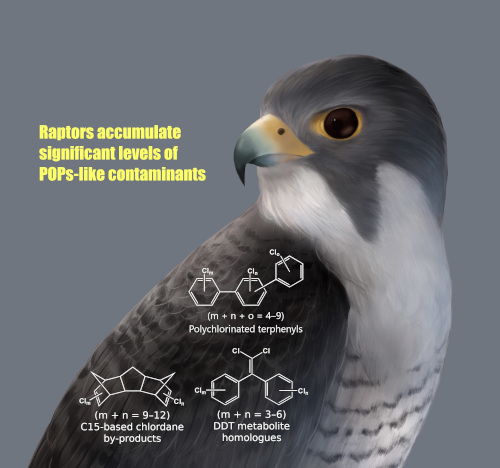Uncommon byproducts of organochlorine pesticides found in the liver of raptors
Knowledge of the detailed accumulation profiles of persistent organic pollutants (POPs) and POPs-like contaminants in wild animals is critical for ecological risk assessment. Comprehensive screening of organohalogen compounds in the livers of wild birds from Osaka, Japan using two-dimensional gas chromatography in combination with high resolution time-of-flight mass spectrometry (GC×GC–HRToFMS) revealed specific accumulation of typically unmonitored POPs-like compounds in raptors.
A research team in Ehime University, Japan conducted a comprehensive profiling of chlorinated and brominated compounds bioaccumulated in the liver of various wild bird species from Osaka, Japan in order to find potentially harmful but “hidden” contaminants. The team found a specific accumulation of several groups of typically unmonitored halogenated contaminants in raptors, including those so far never been reported in wild animals. The findings were published in Environmental Science & Technology on June 8, 2021.
Ecological risk assessment of halogenated contaminants is an important issue, as many of these chemicals persist in the environment, bioaccumulate through the food web, and can cause lasting adverse effects. Chemicals listed as persistent organic pollutants (POPs) under the Stockholm Convention—including legacy industrial chemicals such as polychlorinated biphenyls (PCBs) and legacy organochlorine pesticides such as dichlorodiphenyltrichloroethane (DDT) and chlordane, etc.—are monitored in the environment, animals, and humans by national and international programs, typically using chemical analysis targeting specific predetermined groups of POPs. However, conventional analytical methods cannot detect untargeted contaminants such as chemical synthesis byproducts, and environmental transformation products. There is increasing evidence for the occurrence of many typically unmonitored and unknown bioaccumulative contaminants in the environment and biota, but the accumulation levels and behavior of such POPs-like contaminants in various food webs remain unclear.
The research team in Ehime University used advanced analytical methods based on two-dimensional gas chromatography (GC×GC), time-of-flight mass spectrometry (ToFMS), and software mass spectral filtering for comprehensive profiling of chlorinated and brominated contaminants in the liver of terrestrial and brackish water bird species from Osaka, Japan. Relatively high levels of typically unmonitored halogenated contaminants, including polychlorinated terphenyls (PCTs), various DDT- and chlordane-related compounds, were found in raptors. Notably, chlordane byproducts with C15-based structures were detected for the first time in wild animals and showed high biomagnification potential in the terrestrial food web. These findings highlight the need for further studies on occurrence, structure elucidation and toxicological assessment of unmonitored POPs-like contaminants.
The study was part of an effort to build a complementary digital archive of comprehensive chemical screening data for a chemical monitoring repository for environmental and biological specimens (ChemTHEATRE, Ehime University).
Reference URL: https://pubs.acs.org/doi/10.1021/acs.est.1c00357
Bibliographic Information
Nontarget screening of organohalogen compounds in the liver of wild birds from Osaka, Japan: Specific accumulation of highly chlorinated POP homologues in raptors, Nguyen Minh Tue, Akitoshi Goto, Mitsuo Fumoto, Susumu Nakatsu, Shinsuke Tanabe and Tetsuya Kunisue, Environmental Science & Technology, 55, 8691-8699, doi: 10.1021/acs.est.1c00357, 2021 (June 08).
Fundings
- Japan Society for the Promotion of Science (JSPS): Grants-in-Aid for Scientific Research (A: 19H01167 and 20H00646) and Challenging Research (Exploratory: 19K22911)
- Ministry of Education, Culture, Sports, Science, and Technology, Japan (MEXT): Joint Usage
- Research Center-Leading Academia in Marine and Environment Pollution Research (LaMer)
Media
-

Accumulation of POPs-like contaminants in raptors
Raptors are top predators in the terrestrial food web. High accumulation levels of C15>-based chlordane byproducts, homologues of DDT metabolites and polychlorinated terphenyls in the liver of raptors suggest high biomagnification potential of these typically unmonitored contaminants.
credit : Tatsuya Kunisue, Ehime University
Usage Restriction : Please get copyright permission
Contact Person
Name : Tatsuya Kunisue
Phone : +81899278162
E-mail : kunisue.tatsuya.ew@ehime-u.ac.jp
Affiliation : Center for Marine Environmental Studies (CMES)

